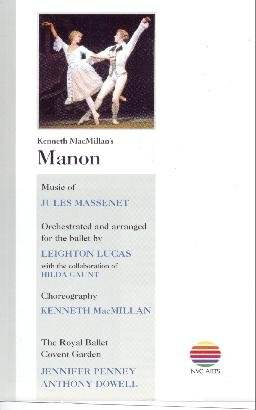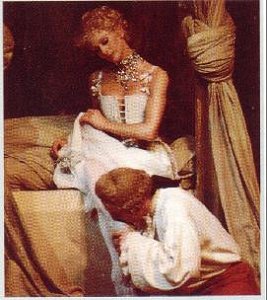Video Review
Kenneth MacMillan's ballet -
MANON With music of Jules
MASSENET
Orchestrated and arranged for the ballet by Leighton
LUCAS (1903-1982).
Choreography by Kenneth MacMillan
The Royal Ballet Covent Garden production of
1982
 WARNER MUSIC/NVC ARTS
8573-84201-3 [130
mins]
WARNER MUSIC/NVC ARTS
8573-84201-3 [130
mins]
Amazon
UK £14.99
Amazon
US $26.99
Manon……………………Jennifer Penney
Des Grieux………………Anthony
Dowell
Lescaut………………… David Wall
Monsieur G.M………… Derek Rencher

Kenneth MacMillan's ballet is a sumptuous production with two marvellous
leads: the stunningly beautiful and supremely graceful Jennifer Penney as
Manon and the athletic yet sensitive Anthony Dowell as Des Grieux. This tragic
lyric ballet tells a moving tale of corrupted innocence in which the lovely
Manon plunges from happiness to grief because of her fatal craving for luxury
at the expense of love. As the Financial Times critic said at the
time (1982) "With performances of this calibre…Manon remains an irresistible
combination of immorality, opulence, suffering and tears."
The story of the ballet is based on the classic French novel, Manon
Lescaut, by Abbé Prévost, or to give it its proper title,
Mémoires et aventures d'un homme qualité. This hot blooded
opus had already been used as a basis for an opera by Massenet with the same
title as this ballet. A new recording of Massenet's opera with Angela Gheorghiu
and Roberto Alagna EMI 5 57005 2 was reviewed on this site recently. Furthermore
Puccini was drawn to the subject and his opera Manon Lescaut, is probably
the most celebrated of all the versions of the story. This site has an article
with comparative reviews of all the available recordings of Puccini's Manon
Lecaut including a review of a video of the Glyndebourne Opera's production.
It is worth comparing the two operas and this ballet. All versions vary in
detail. In passing it should be noted that Daniel Auber wrote another operatic
version of Manon Lescaut in1856; and, furthermore there had been a ballet
by Halévy based on the Prévost story .
But to the ballet. Those expecting Massenet's lovely music from his opera,
Manon, will be disappointed for Leighton Lucas and MacMillan selected music
with strong dancing rhythms from other of Massenet's works. Unfortunately
the booklet tantalisingly does not identify the sources although I think
I detected some material from the Scènes orchestral suites,
for instance. The notes tell us that Leighton Lucas has orchestrated the
music perhaps this includes re-orchestration for the ballet company's orchestra?
Costumes and scenery are a real feast for the eye.
Act I, Scene I is set in the courtyard of an inn. The action opens with the
corps de ballet, as actresses, gentlemen and the demi-mode from Paris, performing
a mix of dances in folk dance and Spanish styles before the arrival of the
dissolute and corrupting Lescaut who, at first, dances in a formal
18th century mode belying his subsequent behaviour. Des Grieux
enters, shy studious and tentative. A coach arrives with the lovely Manon
who is greeted by her brother Lescaut. She immediately catches the attention
of all the men. Some try to snatch her from the attentions of the old man
who had accompanied her on the coach. Amongst them is Monsieur G.M. a wealthy
treasury official. But Manon, who has stolen the old man's purse, elopes
with Des Grieux. But Lescaut promises Monsieur G.M. that Manon will eventually
accept his advances.
Scene II is set in Des Grieux's lodgings and in an extended and beautifully
choreographed, romantic pas de deux, Manon and des Grieux celebrate
their love. But when Des Grieux goes off on an errand, Lescaut appears with
Monsieur G.M. who has brought with him sparkling jewels and a luxurious cloak.
Manon is mesmerised by the luxury and in a seductive pas de trois
she succombs to temptation and leaves with her new richer, but older lover.
Lescaut remains behind and tries to persuade Des Grieux to allow the liaison
'saying' there will be wealth for all.
Act II, Scene I is set at a party given by Monsieur G.M. The action begins
with various dances by the corps de ballet: coquettish movements by grisettes
and more elegant measures by ladies of quality. Lescaut arrives drunk and
in one of the highlights of the evening, he engages in an inebriated comic
dance with his mistress. A downhearted Des Grieux mingles in the background
until he sees Manon, sumptuously dressed and adorned with jewels, arriving
on the arm of G.M. While G.M. relaxes at the card table she, seemingly oblivious,
is passed around and manhandled by his lascivious cronies. Seen through the
eyes of Des Grieux, this is a most disturbing dance; ghostly, almost murky
music is used to underline Manon's degradation. Des Grieux tries to persuade
Manon to leave with him but she will only agree if he takes more money from
G.M. at cards But he is caught cheating at cards by G.M. Only after a sword
fight in which Des Grieux wounds G.M., can Des Grieux and Manon slip away.
Scene II opens with another beguiling romantic pas de deux. This is
interrupted by the arrival of G.M., with the police, thirsting for revenge.
Manon is arrested as a prostitute and in a violent scuffle, a repentant Lescaut,
now siding with his sister, is shot for his treachery by G.M.
Those who know the action of both Masenet's and Puccini's operas will have
realised by now how much the plot of MacMillan's ballet differs. This is
clearly to do with the special requirements of the medium of the ballet.
For the action in Act III, MacMillan appears to have gone back to Prévost
for inspiration. Whereas the inter-linking action between the acts of Puccini's
opera is only indicated in programme notes, that drama best suites the ballet.
Scene I is set in the Port of New Orleans and the disembarkation of
the prisoners amongst whom is Manon (with Des Grieux who had accompanied
her as the ship's cabin boy). The Scene opens with the Gaoler of the Penal
Colony supervising this disembarkation. An affecting, dejected dance for
the women prisoners precedes the arrival of Manon now in rags and hair in
complete disarray. Nevertheless, her beauty is still tangible and it arrests
the attention of the Gaoler and in a violent dance with Des Grieux he tries
to seduce her away from him. Manon is then led away in chains leaving a
distraught Des Grieux to follow. The brief Scene II sees the Gaoler trying
to seduce a weary and unwilling Manon. As he tries to tempt her with a bracelet,
he is killed by the newly arrived Des Grieux. The ill-fated lovers escape.
The final Scene III finds them exhausted in the swamps of Louisiana. Ghostly
visions of their earlier life in Paris haunt them and Manon sinks to the
ground. A desperate Des Grieux tries to revive her but after a last sad,
mournful pas de deux she expires.
There is no doubt that this production has its longueurs, particularly in
Act III, despite MacMillan's inventions, and especially after all the glitter
of the first two acts. Nevertheless, this is delightful evening's entertainment
and the music, although rather superficial, is charming enough.
Ian Lace



